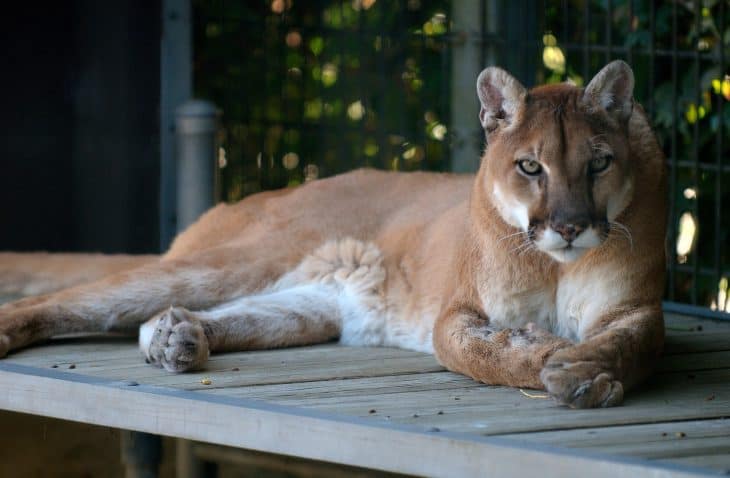
- Scientific Name: Puma concolor
- Class: Mammal
- Order: Carnivore
- Subspecies: There are 6 recognised subspecies of cougar
- Lifespan: 10 years in the wild; 20 years in captivity
- Abilities: Cougars are good swimmers, although they prefer not to enter water
- Senses: Cougars have a poor sense of smell
- Conservation: Almost 2,100 cougars are killed every year
- Captivity: There are 334 cougars in zoos worldwide, with 119 being in US zoos
- Emblems: Cusco, an ancient Incan city, was designed in the shape of a cougar
- Size: Cougars Are the Second Largest Cats in North America
- Coloring: A Cougar’s Coat Contains Several Colors
- Athletic Ability: Cougars Can Jump 20 Feet in the Air
- Athletic Ability: Cougars Are Incredible Sprinters
- Diet: Cougars Hunt Everything from Moose to Insects
- Behavior: Cougars Hide and Store Their Food
- Parenting: Only Female Cougars Are Involved in Parenting
- Coloring: Cougar Cubs Have Blue Eyes
- Predators: Fully Grown Cougars Have No Predators Except Humans
- The Cougar Population Faces Several Threats
- Cougars Are Solitary and Secretive Animals
- Cougars Are Crepuscular Animals
- The Equator as a Weight Loss Strategy? The Size of a Cougar
- Depends on the Latitude of Its Location
- Cougars Are Unable to Roar
- The Cougar Holds a Guinness World Record
- Cougars Have the Biggest Range of Large Animals In The Western Hemisphere
- Puget Sound Natives Believed That Cougars Started Fires
- The Black Cougar Is a Myth
Cougar Facts Infographics

Cougars Are the Second Largest Cats in North America
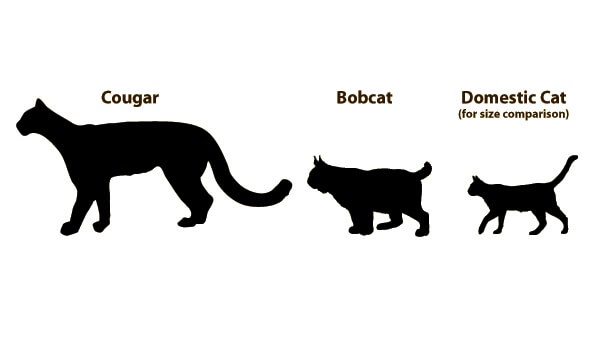
The cougar is the second largest cat in North America. Cougars are typically 5 to 9 feet (1.5 to 2.75 meters) in length, and reach a height of 2 to 2.5 feet (60 to 76 centimetres). Male cougars weigh in the region of 115 to 198 pounds (53 to 90 kilograms), while females are slightly lighter at 64 to 141 pounds (29 to 64 kilograms).
A Cougar’s Coat Contains Several Colours
It is interesting to look at a cougar’s coat in detail and notice the different colours. Cougars’ coats vary from a reddish colour to a greyish tan hue. All cougars have lighter fur on the underside and muzzle, and a black tip on their tails, as well as black markings on their faces and ears. When cougar cubs are born, they are usually covered in black spots, which act as camouflage to help them blend into their environment. This usually lasts for approximately six months.
Cougars Can Jump 20 Feet in the Air
One of the most astounding cougar facts is that these cats can jump an impressive 20 feet into the air. Their predatory pounce is just as impressive: cougars can pounce on prey that is as far away as 20 to 40 feet – and that’s from a standing position!
Cougars Are Incredible Sprinters
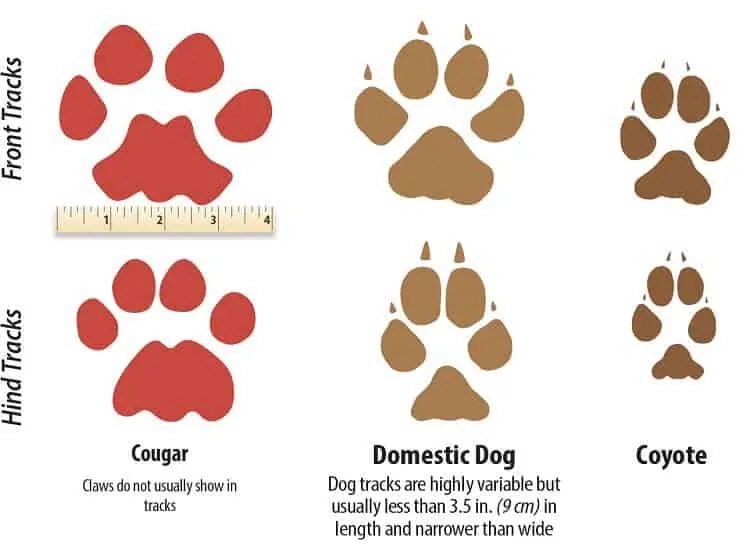
Another of the more impressive cougar facts is the cougar’s sprinting ability. A cougar can reach speeds of 35 to 45 miles per hour (55 to 72 kilometres per hour). It performs well in both leaping and short sprints because it has large paws, and proportionally the largest hind legs of all the wild cats. In fact, this animal’s hind legs are noticeably larger than their front legs. As such, cougars are not built to run fast over long distances.
Cougars Hunt Everything from Moose to Insects

One of the more interesting cougar facts is that these big cats include a wide variety of other animals in their diet. Although they will eat mostly ungulates, such as deer, moose and bighorn sheep, they will also prey on horses, sheep, and domestic cattle. What is probably most interesting is that cougars will even prey on small critters, such as rodents and insects.
Cougars Hide and Store Their Food
One of the lesser known cougar facts is that these animals tend to hide and store their food. Once they have made a kill, cougars will in fact hide the carcass (often covering it with sticks and leaves) as a means of storing their food. Cougars return to their food store over the course of several days in order to feed.
Only Female Cougars Are Involved in Parenting
Female cougars reach sexual maturity at some point between one and a half and three years of age. Throughout their reproductive life, female cougars will generally have one litter of cubs every two to three years. The gestation period lasts from 86 to 104 days. Each litter will typically consist of two to three cubs. The mothers are fiercely protective of their cubs, and they need to be because male cougars are not involved in parenting at all.
Cougar Cubs Have Blue Eyes
One of the most fascinating cougar facts is that cougar cubs have blue eyes. Cougar cubs are born blind, with their eyes closed, just like domestic kittens. At about two weeks old, the cubs are able to open their eyes, revealing bright blue irises. It takes about 16 months for their eyes to become the greenish yellow colour that is associated with adult cougars.
Fully Grown Cougars Have No Predators Except Humans
Mature cougars are free to roam their territories free from the threat of predators, apart from humans. However, this does not mean that the cougar is the apex predator throughout its range; cougars frequently have to compete with other predators for food. In the northern part of its range, the cougar interacts with other predators. such as the grey wolf and brown bear. Cougars in Florida have to contend with American alligators. Towards the south of its range, the larger jaguar poses competition.
The Cougar Population Faces Several Threats
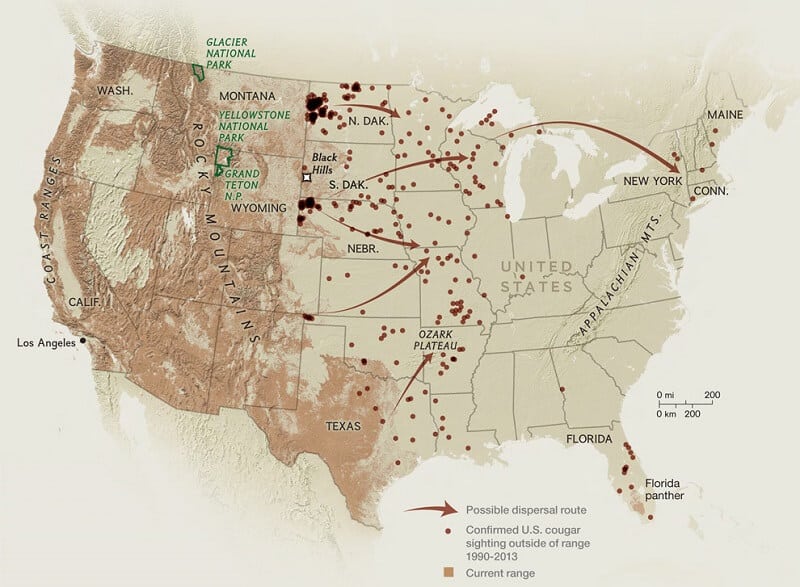
There are several threats to the cougar population, including: hunting, habitat loss, habitat fragmentation, and car accidents. In the 1700s, European settlers almost wiped out the cougar population in the eastern parts of Canada and the United States.
It is legal to hunt cougars that live in the western parts of Canada and the United States (except for California). Although the cougar population has significantly decreased, they are not regarded an endangered because many cougars still live in the wild. However, one of the most concerning cougar facts is that two subspecies, the Florida panther and the Eastern cougar, are critically endangered.
Cougars Are Solitary and Secretive Animals
Cougars are regarded as solitary and secretive animals. In this way, they are very similar to many other cats in the wild. The only group that you might see will be a mother with her cubs. Adult cougars will only meet in order to mate.
Cougars Are Crepuscular Animals
Cougars are crepuscular, which means they are usually active around dawn and dusk. They have excellent night vision which enables them to effectively stalk their prey at these times of day when there is less light, giving them a distinct advantage. This low light also acts to better camouflage the cougars from their prey.
The Size of a Cougar Depends on the Latitude of Its Location
One of the most intriguing cougar facts is that the size of a cougar depends on where on the continent it is found. The latitude of the cougar’s habitat is the most significant factor in determining its size. Cougars found nearer the equator are generally smaller, with the size increasing towards both the north and south poles.
Cougars Are Unable to Roar
When you imagine a wild cat, you often tend to think of a lion roaring. However, one of the more surprising cougar facts is that cougars are not able to roar. Instead, these fierce cats actually purr – just like a regular domesticated house cat! Strangely, cougars have also been heard to scream, squeak, hiss and even whistle.
The Cougar Holds a Guinness World Record
You will be amazed to learn several cougar facts relating to the name of this animal. In fact, the cougar holds the Guinness World Record for the animal with the highest number of names. There are over 40 names for a cougar in the English language alone!
These names include: panther, puma, mountain lion, mountain cat, deer tiger and catamount. The name by which the cougar is known differs from region to region. However, it is important to note that a cougar is not the same animal as a lynx, bobcat, leopard, cheetah, or jaguar.
Cougars Have the Biggest Range of Large Animals In The Western Hemisphere
Cougars have the most expansive range of all large wild terrestrial animals found in the Western Hemisphere. The cougar range extends from the Yukon in Canada all the way to the southern Peruvian Andes of South America. They live in a range of ecosystems, from sea-level to mountains, and from wetlands to desert, although they do seem to prefer canyons and dense brush. Cougars will establish themselves wherever they find shelter and prey.
Puget Sound Natives Believed That Cougars Started Fires
There are several cougar facts pertaining to cultural beliefs. The Puget Sound natives referred to the cougar as the fire cat. They believed that cougars would carry fire from the Olympic Mountains to Mount Rainier every autumn, and start forest fires along the way.
The Black Cougar Is a Myth
One of the most controversial cougar facts is the debate surrounding the existence of black cougars. Although there is some historical anecdotal evidence, scientists and zoologists claim that there is in fact no such thing as a black cougar (also referred to as a black panther).
In fact, no scientifically confirmed preserved specimen of a black cougar exists. The explanation that is most frequently provided for this myth is that people have spotted or encountered other cats with melanistic (black) colouring and mistaken them for cougars.
Cougar Facts – Facts about Cougars Summary
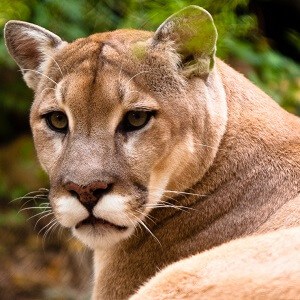 Cougars are large wild cats that are found in North and South America. These solitary crepuscular animals are powerful sprinters and hunters. There are many different names for cougars and they are often confused with other big cats, which might account for the myth surrounding the existence of the black panther.
Cougars are large wild cats that are found in North and South America. These solitary crepuscular animals are powerful sprinters and hunters. There are many different names for cougars and they are often confused with other big cats, which might account for the myth surrounding the existence of the black panther.
Was this page helpful?
Our commitment to delivering trustworthy and engaging content is at the heart of what we do. Each fact on our site is contributed by real users like you, bringing a wealth of diverse insights and information. To ensure the highest standards of accuracy and reliability, our dedicated editors meticulously review each submission. This process guarantees that the facts we share are not only fascinating but also credible. Trust in our commitment to quality and authenticity as you explore and learn with us.
